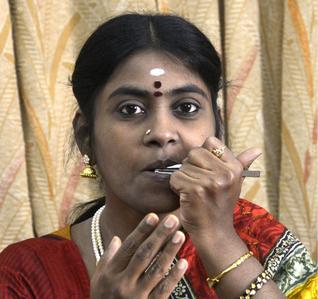Sunitha Chandrakumar is an extraordinary musician who is a worthy feather in the cultural crown of Mysore! She is a great example of how a woman can succeed in this male-dominated music industry, especially in the aspects of music composition. To her credit, she has around 10 marvellous music albums composed by herself and sung by some of the big shots of Indian Music Industry like Shreya Ghoshal, S.P. Balasubramanyam, Vijay Prakash, Praveen Godkindi and many others. To back her constant success, she has around twenty years of strong foundation in various forms of music.
by Phalgunn Maharishi
Born in Mysore, Sunitha grew up in an environment filled with music and dance. Sunitha said, “My father had a deep interest in Bhajans and Bharatanatyam and my mother used to sing devotional songs and light music. My two sisters were learning Veena. The whole family had pledged itself into the deep roots of music and dance. Probably that was my inspiration.”
Sunitha as a kid learnt Karnatak music under Vijayalakshmi and Bharatanatyam under Vishnudas which she pioneered in a span of around eight years. While speaking about her interest in music, Sunitha said, “I was always very much active in co-curricular activities during my school and college days which opened up many opportunities to me.”
“During every school programme, I was initially made to stand in the last row, the reason being my height! But, later due to my interest and confidence I guess, I was given opportunities to lead the group from the front line,” she adds with a smile.
According to Sunitha, she slowly started shifting her interest towards light music when she went to Bangalore to pursue her graduation at the Central Institute of Home Science. In her own words she said, “Only after I met Mysore Ananthaswamy in Bangalore, my interests in lyrics started growing more. I started feeling that I could play more with words only through light music and not classical.”
She added, “I never knew I was so interested in music until I completed my PU. It was only during the last year of my graduation that I started framing my aims and dreams properly, which paved me a way for an opportunity to understand music in-depth.”
Sunitha got married in 1992 to Chandrakumar, a business person and came back to Mysore to lead her family life. While speaking about her life back in Mysore, she said, “My husband started supporting me very much and he started observing my interest in music as his own. I then got an opportunity to learn under H.R. Leelavathi for the next ten years!”
“My concentration in learning music had grown to a great extent and I was always inspired seeing the postures of Leelavathi Madam standing in a corner during the classes and composing a tune,” she said adding, “I too started dreaming about my compositions !”
While speaking about her first time experience in music composition, Sunitha said, “Usually Leelavathi Madam used to give the tunes and lyrics for us during our performances at Akashvani. But, once she had been abroad and there was a sudden programme for which we had to get ready. So, I immediately took an initiative and composed the tunes for it. It was a shocking news for our madam but she was happy with it.”
Sunitha then started composing music slowly one by one and very soon her interests got tuned up and she also started teaching music through her very own ‘Raghuleela School of Music.’ She on behalf of her music school started producing many thematic live programmes. Her very first such programme was Janapada Sirigandha. Sunitha said, “It was truly a great experience working on my first thematic live programme with my school students participating in it.” She also commented that many people were sarcastic at her efforts, but only after seeing her success they truly appreciated her!
Sunitha Chandrakumar is very much known in the music industry for developing her own style of music composition. The perfectionist composer then started concentrating more on composing and producing music albums. Sunitha said, “I can proudly say that my album Baandhevi was the first ever singing attempt by Shreya and Chitra in Kannada light music.”
She also added, “We have a co-ordinator by name Mysore Sudarshan who helps me in booking the singers and completing the album.” Sunitha said that she is very much thankful to all the musicians for tolerating her strict and unique style of working. She said, “I am very much particular when it comes to my work and I always believe in working from 9 am to 9 pm with all the musicians assembled together recording the track live,” with a smile on her face.
Sunitha Chandrakumar always worked with a strong belief that running behind money would not fetch any satisfaction in life. Thus, she ran behind her dreams trying at all odds to make them come true! Being a truly dedicated music composer from Mysore, Sunitha said that she has now become addicted towards music composition. Her students too have earned good name and fame in the music industry today with many being popular participants of music reality shows like “Ede Thumbi Haaduvenu” and “Confident Star Singer.”
Sunitha is also a proud recipient of the Best Music Composer award in the light music genre at the Karnataka International Awards held in 2013 at Bangalore.
Mysore city is really proud of such great talents who have taken light music from their home in Mysore all the way to the studios in Mumbai! Dedication at this best is what one can see in Sunitha.
She can be reached through 9945307633.
source: http://www.starofmysore.com / Star of Mysore / Home>Feature Articles / Thursday , October 16th, 2014







